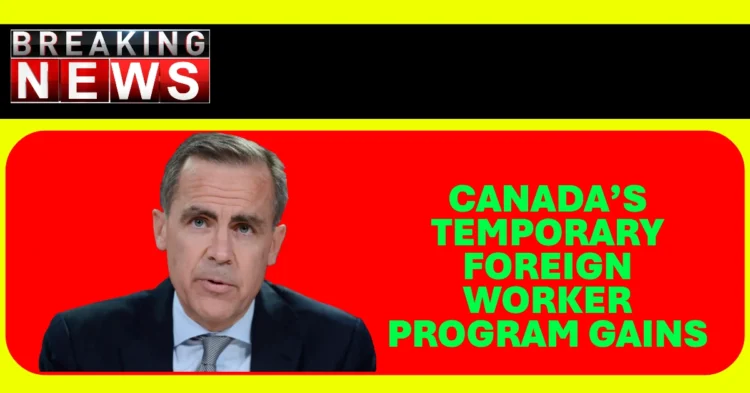Conservative Member of Parliament Jamil Jivani has ignited a fiery national debate by launching a petition to terminate Canada’s Temporary Foreign Worker Program (TFWP). Excluding the Seasonal Agricultural Worker Program, Jivani’s initiative claims that the TFWP is exacerbating Canada’s economic woes—driving up youth unemployment, fueling a housing crisis, and putting immense pressure on public services like healthcare and education.
The petition has quickly gained traction online, drawing support from Canadians frustrated by job scarcity, rising living costs, and stagnant wages. Jivani’s message is clear: Canadian jobs should go to Canadian workers first—especially young people struggling to enter the workforce.
Table of Contents
The Central Claims Behind Jivani’s Petition
Immigration and Economic Strain
Jivani argues that the TFWP contributes to what he describes as “unsustainable immigration levels.” He links the surge in temporary foreign workers to worsening shortages in housing, hospital space, and public infrastructure.
Displacement of Young Canadian Workers
With youth unemployment reaching 14% in April 2025—its highest point since the COVID era—Jivani contends that the TFWP is directly competing with young Canadians for entry-level jobs. In major urban centers like Toronto, the number of unemployed youth has ballooned, with over 120,000 young people jobless in 2024 alone.
Wage Suppression in Key Industries
The petition claims that the presence of temporary foreign workers has allowed businesses to keep wages low. Rather than investing in local training and skills development, employers are relying on a steady influx of foreign labor willing to work for less.
Youth Unemployment: The Heart of the Debate
Why Are Young Canadians Being Left Behind?
According to the petition, industries such as food service, hospitality, and retail have been flooded with foreign labor, shutting young Canadians out of the job market. A prime example: Tim Hortons hired over 700 temporary foreign workers in Ontario in 2023 alone, compared to just 58 in 2019.
Jivani insists that terminating the TFWP (excluding agricultural workers) would push employers to invest in Canadian workers, improving wages and long-term employment prospects.
“Instead of investing in our people, we are relying on cheap labour from abroad,” Jivani declared.
Government Pushback and Proposed Reforms
Ottawa Responds
Employment Minister Patty Hajdu has defended the TFWP, citing recent reforms aimed at curbing its misuse. These include:
- Capping TFWP admissions at 82,000 annually from 2025 to 2027.
- Rejecting applications in metro areas with unemployment rates above 6%.
- Increased consultation with industry and labor groups to ensure the program aligns with Canadian job market needs.
While Hajdu acknowledged the program’s flaws, she emphasized that it remains vital for seasonal industries like agriculture and tourism, which rely heavily on temporary labor.
Conservative Party’s Silence: An Independent Campaign?
Interestingly, Jivani’s petition has not received public support from key Conservative figures. Immigration critic Michelle Rempel Garner and employment critic Garnett Genuis have remained silent, suggesting that Jivani may be acting outside the party’s official stance.
This independence could either hurt or help his cause, depending on how public sentiment shifts in the coming months.
Understanding the Temporary Foreign Worker Program
How the TFWP Works
The TFWP allows Canadian employers to hire foreign nationals when no suitable Canadian candidates are available. It is divided into several streams:
- High-Wage Workers
- Low-Wage Workers
- Global Talent Stream (for tech and R&D roles)
- In-Home Caregivers
- Seasonal Agricultural Workers
- Foreign Academics
To hire under the TFWP, employers must secure a Labour Market Impact Assessment (LMIA), proving the job cannot be filled domestically.
The Numbers Behind the Program
In 2024 alone, over 160,000 work permits were issued through the TFWP—highlighting the scale of foreign labor in Canada’s economy. Critics argue this is far too high, particularly for low-wage sectors.
What Happens Next? Possible Outcomes and Consequences
1. Stricter Reforms Likely
Even if Jivani’s petition doesn’t lead to a full termination of the TFWP, it could accelerate reforms—especially in limiting the use of temporary labor in high-unemployment areas.
2. Separation of Agricultural Labor
Jivani suggests carving out the Seasonal Agricultural Worker Program as a separate entity, given its unique and essential role in Canada’s food supply chain.
3. Shift in Employer Responsibility
Ending or reducing the TFWP could force businesses to invest in upskilling Canadians and improving job quality, addressing long-standing concerns from labor unions.
4. Polarization of Public Opinion
While some Canadians view the TFWP as an economic necessity, others see it as a mechanism that prioritizes corporate profit over national workforce development.
Is Public Opinion the Deciding Factor?
As Jivani’s campaign gains momentum, public reaction will be pivotal. Canadians increasingly frustrated by affordability issues and limited job prospects may rally behind his message. However, employers and pro-immigration advocates argue that the TFWP fills essential roles that locals are unwilling or unavailable to take.
The conversation is far from over—and the future of the TFWP now hangs in the balance.
Quebec New Immigration Cap for 2024-2025: Overview of Changes and Implications
Mark Carney’s Bold Immigration Strategy What It Means for PRs, Students, in 2025
Canada Increases Immigration Fees for Temporary Residents Starting December 1
IRCC Extends Public Policy for Immigration Medical Examination Exemptions until 2029
Final Thoughts: A Defining Moment for Canadian Labor Policy
Jamil Jivani’s petition to end the Temporary Foreign Worker Program marks a bold challenge to Canada’s current immigration and labor strategies. Whether seen as necessary reform or political overreach, it underscores a growing tension between economic growth and social equity.
As unemployment rises and public services are stretched thin, Canadians are demanding answers. And as this petition continues to make headlines, the federal government may be forced to make more than just incremental changes.

